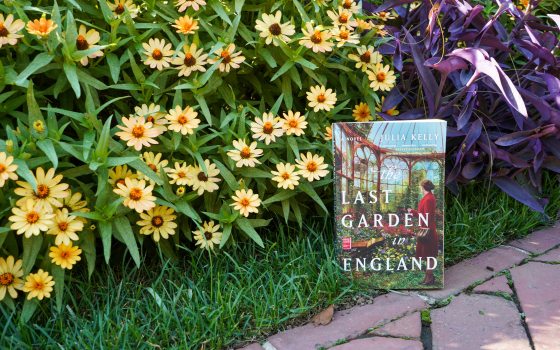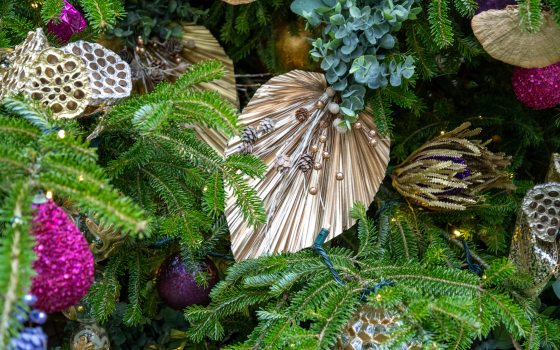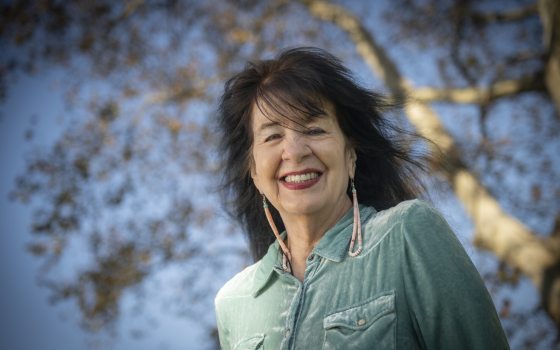Gardens can be healing. Gardens can be timeless. Gardens can tell stories if you listen and observe. Growing up in a small, rural town in the South, The Secret Garden (our 2024 Community Read selection for our youngest readers) sparked my imagination at an early age with the idea of gardens as cloaked in mystery and secrets, filled with hidden beauty (and stories) waiting to be revealed. I entered every garden with the eye of a detective and a gentle, delicate touch so as not to abruptly disturb the plants. I expected all gardens to have been designed with personal and powerful reasons in mind and to outlive their designers, owners, and caretakers, leaving the garden with an intriguing (and likely forgotten) story to tell … if I could learn how to listen. That perception is not too far off in The Last Garden in England (our 2024 Community Read selection), as author Julia Kelly beautifully brings those elements together in a moving, multi-generational tale.
Centered on the garden at the fictional estate called Highbury House, the garden’s story begins in 1907 when an ambitious female designer is tasked with its creation. Next are the years during World War II and the impact of the war and the time the house is transformed into a military hospital. Last is present day, when another female garden designer follows her passion
to bring neglected gardens back to life. These three stories are gracefully intertwined to create a touching and healing story of the garden—its endurance to provide love, refuge, and hope throughout the years and generations.
I had the great pleasure to talk with Julia about the creation of this lovely story, what gardens mean to her, and what they can mean to all of us.

Author Julia Kelly. Photo by Scott Bottles.
This is such a moving story, expanding across generations. Please tell us about your inspiration for Highbury House and its garden.
I’ve always wanted to write a book about a garden that connects stories of women through different generations. When I started to think about what that would be, I live in the UK now, and despite being American, I’ve always had this interest in English gardens and the tradition of gardening in England. My father is a great gardener as well; he has a beautiful garden here in England. I wanted to look around some of the historic gardens in the area I was looking to set the book, which is in Warwickshire, and I struck upon several different gardens that all became Highbury in different ways.
Hidcote is a famous one and it became the inspiration for the different garden rooms that I designed for Highbury. Each garden room has a different theme, and it connects into something that the woman designed in the earliest storyline.
There are three storylines and the woman in the early storyline who designs the garden, Venetia Smith has a theme going through this garden. You learn what that is throughout the book. Hidcote really created the inspiration for that.
There were some other gardens as well. The White Garden at Sissinghurst Castle, which I’ve been to and is stunningly beautiful, became the inspiration for the bridal garden in the book. I pulled bits and pieces of real places in to create my fantasy garden, the garden that I would have if I had the space and the house and the time. It was a real joy to create that and live out my horticultural fantasy.
What was your approach to the research necessary to write such a moving and intertwined story?
I expected to bring different pieces of my own knowledge together because, at the point in time when I wrote the book I had never had my own garden to design and create and maintain myself, but I had often been by my dad’s side while he was doing that, both in Southern California where I grew up and then also in England. So I thought, “No problem, I’ve got this covered.” I was very arrogant and very wrong and I quickly realized how wrong I was when I sat down and started to try to describe not only what these spaces would have looked like, but the sort of philosophy behind why my character, Venetia, was doing what she was doing, what that would have represented, even the seasons.
Growing up in Southern California, it’s a different climate and seasonal cycle than here in the UK. So there are different things that would have grown differently at different times. I realized very quickly that I needed to do a lot of research. Fortunately, there are a lot of resources available online. Master gardeners are incredible and incredibly generous with their time and their knowledge. Also, I was lucky in having my dad jump in as almost a de facto research assistant. That is wonderful because shortly after this book came out I moved into a flat with my own garden, so I was able to take some of the things that I had chosen out of the book and highlight different plants. I was able to put my stamp on my own space for the first time, which was a lot of fun, a lot of hard work, but a lot of fun.
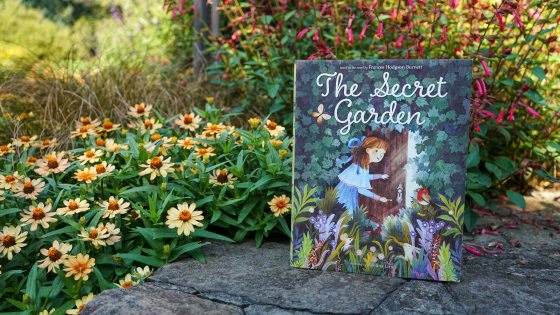
A picture book for our youngest readers, The Secret Garden is adapted by Calista Brill and based on the novel by Frances Hodgson Burnett. Bold, beautiful illustrations share the story of Mary Lennox’s move into the mysterious Misselthwaite Manor, her explorations of the manor’s gardens, and the surprises, secrets, and friendships she discovers along the way. For readers new to the story and seasoned fans alike, this is a lovely adaptation of a timeless story. Photo by Carol Gross.
In the last sentence of the Author’s Note you say, “It is up to us to remember to pause and enjoy that beauty every day” (p.351). How do you do that for yourself?
One of the things that I realized as I was writing this book was how much of my life I enjoyed spending outdoors in the natural world. I’ve lived in cities for my entire adult life. I grew up in a city and I don’t think I realized how much parks and tree lined streets and river walks and different things, depending on where I was living, really made a difference. And again, I wrote this book before the pandemic. I edited it during the pandemic, and then I promoted it as we were going in and out of lockdowns in the UK. And one of the things that people who didn’t have that green space and that access realized, and I was one of those people, was how much it has an impact on our lives, how much we use these places and how much we enjoy them, whether it’s walking or enjoying foliage changing or flowers blooming. Taking the time to notice those little things is a very lovely thing to be present for and be mindful of, especially in places where you do see a change of seasons.
It’s currently very gray weather, it’s very rainy. But I’ve always liked this kind of transitional time, this change of season from the summer into the autumn, into the winter, because it’s a very natural cycle. It marks the year moving on. And by the same token, I absolutely love that first really beautiful day of spring where you just have all this sunlight and warmth that you haven’t seen for months and months. I think taking those moments to appreciate that can have a big impact on me and my enjoyment of the world in general.
How can public gardens, such as Longwood and Hidcote, encourage such appreciation for nature and its beauty?
I know my interest came from early engagement—being around gardens, being around my dad, and through school field trips. I do think that there is absolutely an educational outreach element of that, getting people in early. But I have to say, one of the things that’s been satisfying for me as an adult is realizing that something that I’m putting time and effort and planning into can produce something. I think there’s real joy in even little seeds in a pot on the windowsill. There can be a real joy in seeing that grow and develop, it’s so satisfying. It also requires patience and sometimes things don’t go as you think they’re going to go. Learning that whole process along the way can be a real joy for people, whether you’re starting at a very young age or are older. Getting that sort of involvement and understanding what it’s like to have even a window box can trigger that interest.
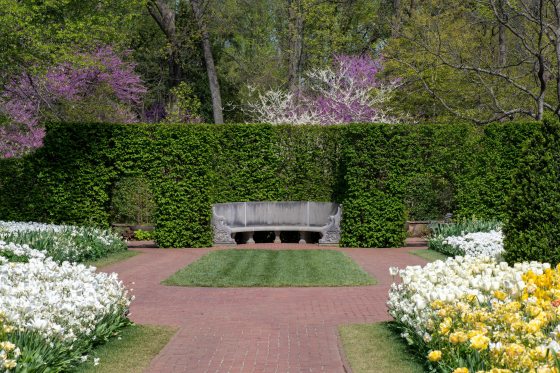
The historic Whispering Bench at Longwood Gardens was added in 1910 by our founder, Pierre S. du Pont, who enjoyed surprising garden elements. Located at the East end of Flower Garden Walk, the 25-foot semi-circle bench is known for its detailed carvings and impressive acoustics. Take a moment to share a secret—or listen for one. Photo by Hank Davis.
You’ve written numerous historical fiction books featuring strong and remarkable women. How have these women influenced or inspired your own life?
I think every author, whether they admit it or not, often writes into their books an element either of themselves or of the person they would want to be. In the cases of the women in The Last Garden in England, there are elements of them that are the best version of myself that I would want to be. I want to be a little bit bolder and a little bit more warmhearted or open or curious. There’s always that temptation to kind of write the character that you would love to be, or you’d love to sit down and have a drink with or chat with. All of five of these women have an element of that.
I enjoyed writing Venetia Smith because she is based on several female garden designers from the turn of the 20th century, and in particular Gertrude Jekyll, who is an interesting person. She’s one of the big movers and shakers, changing the style of gardening at the time and really creating that English cottage style garden that a lot of people think of when they think of English gardens. For example, painting with impressionistic swathes of color and lots of things going on in borders. It looks naturalistic, although of course everything’s very controlled because gardening does have that element of trying to influence the natural world. She’s a fascinating figure and one who was doing things that a lot of women were not doing at the time. She was working for herself. She created a business and a name and a reputation for herself. She was writing articles and books, and I think that there’s a lot to admire about that, and I think there’s a lot that’s interesting about people who’ve lived a life that isn’t the easiest choice, let’s put it that way, compared to what was going on in society at the time.
As shown throughout The Last Garden in England, gardens hold secrets as well as hope and healing. What do you hope readers take away from this story?
I hope readers will take a moment to pause and look around them and look at the world and the seasons and plants and nature as things change. One of my favorite things about writing this book was how much I got to enjoy the process of writing it, not worrying necessarily about finishing it. It was such a joy to sit down and get lost. And in writing this book, I hope that I can give people a little bit of escapism but also give them a reminder to look around and enjoy the world around them as it goes by.
Editor’s note: Hear more from Julia about the inspirations for and the process of writing The Last Garden in England at our virtual event, “Looking Back to Create Something New” on Tuesday, March 26 from 6:30-7:45pm. This event is free, livestreamed online, and open to all. Register now. Interested in traveling to intricately designed, arts-and-crafts-inspired Hidcote Manor Garden, as featured in The Last Garden in England—from home? Register for an upcoming discussion and virtual tour of Hidcote’s garden areas led by its general manager and head gardener on April 16. For additional Community Read events hosted by partner libraries and cultural institutions, please take a look at the Community Read Events Calendar.
